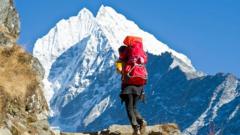Nepal is recognizing and acting on the potential to bolster tourism beyond its iconic Everest, aiming to enhance the economy of the Karnali and Sudurpaschim provinces, regions that have historically struggled with both accessibility and tourism engagement. As the government implements this measure, concerns remain regarding the infrastructure and capacity of these remote areas to handle increased visitor numbers.
Local tourism leaders are optimistic the initiative will lead to economic growth and job creation. However, with Everest's permit fees climbing to $15,000, and with many climbers focused intensely on this peak, the challenge remains to garner interest in the lesser-known 97 summits.
Recent statistics reveal that only a fraction of climbers have explored these remote mountains. Contrastingly, Everest sees significant numbers, prompting policy shifts aimed at managing climbing traffic. The new legislation, suggesting climbers must first summit a mountain above 7,000m in Nepal, positions these lesser-known peaks as potential training grounds.
While the offer of free climbs has sparked interest, the true test will be whether the necessary support systems are in place to sustain an influx of adventurous travelers while preserving the region's natural beauty and indigenous ways of life.
Local tourism leaders are optimistic the initiative will lead to economic growth and job creation. However, with Everest's permit fees climbing to $15,000, and with many climbers focused intensely on this peak, the challenge remains to garner interest in the lesser-known 97 summits.
Recent statistics reveal that only a fraction of climbers have explored these remote mountains. Contrastingly, Everest sees significant numbers, prompting policy shifts aimed at managing climbing traffic. The new legislation, suggesting climbers must first summit a mountain above 7,000m in Nepal, positions these lesser-known peaks as potential training grounds.
While the offer of free climbs has sparked interest, the true test will be whether the necessary support systems are in place to sustain an influx of adventurous travelers while preserving the region's natural beauty and indigenous ways of life.




















